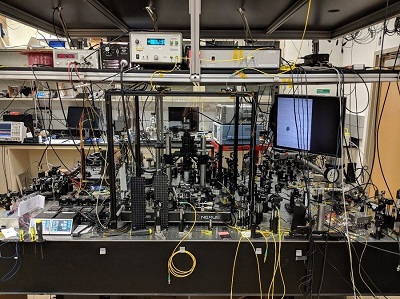
Versatile Spectroscopy System Acquires Data at Exceptional Speeds Across Platforms
Electro-optic combs operating at gigahertz pulse rates have enabled a dual-comb spectrometer capable of acquiring data at exceptionally high speeds to perform linear absorption spectroscopy on gases of different pressure. Though the experiments are only cursory demonstrations, the results suggest that the advanced spectrometer has potential use in chemical studies in high-pressure environments, such as in power plants and jet engines, and in making spectroscopic measurements of fast and nonrepeatable events.
As the spectrometer can measure a full spectrum in seconds, according to the team responsible for developing it, other applications include those that perform quality-control functions for pharmaceuticals or semiconductors on a production line, as well as the video imaging of biological samples.
In addition to pressurized gas experiments, the team of Scott Papp from the National Institute of Standards and Technology (NIST) and the University of Colorado, as well as David Carlson and Daniel Hickstein, introduced the spectrometer with experiments involving semiconductor wafers. The team said its research focused on building new, high-speed frequency combs capable of being used to construct a spectrometer that operates hundreds of times faster than existing technologies.
As well as extremely fast acquisition times, the researchers prioritized a dual-comb system with a wide range of colors. To do so, they incorporated techniques from across disciplines into their research — including microscopy, nanofabrication, and microwave electronics.
The frequency combs in the new system use an electronic signal-driven optical modulator to carve a continuous laser beam into a short pulse sequence. The pulses of light pass through nanophotonic nonlinear waveguides on a microchip, simultaneously generating many colors of light in an output known as a supercontinuum. The output enables precision spectroscopic measurements of solids, liquids, and gases.
In the system, it is the chip-based waveguides, functioning as channels, that confine light within structures that are 1 cm long, yet only nanometers in width. The (small) size of these channels, low light losses, and properties of the material from which they are manufactured combine to effectively convert light from one wavelength to another, establishing the continuum.

The optical setup of the dual-comb spectrometer with an acquisition speed of 10 GHz. Courtesy of David Carlson, National Institute of Standards and Technology and the University of Colorado.
The distinct frequency comb source (compared to that in/from other dual-comb systems) ensures exceptionally high degrees of reliability and tunability of the laser across a range of operating conditions, Carlson said. That feature is vital when exploring future and forthcoming applications, particularly outside a controlled laboratory environment.
The spectrometer is versatile and has successfully performed nonlinear Raman spectroscopy on semiconductor materials. Nonlinear Raman spectroscopy had not been previously performed using an electro-optic frequency comb.
The researchers are currently improving system performance to prepare the spectrometer to perform real-time applications such as biological imaging. “In biological imaging, the ability to create images in real time of living tissues without requiring chemical labeling would be immensely valuable to biological researchers,” Carlson said.
The team is also working to shrink and simplify its experimental setup so it can operate outside the lab.
The research was published in Optics Express (www.doi.org/10.1364/OE.400433).
Published: September 2020